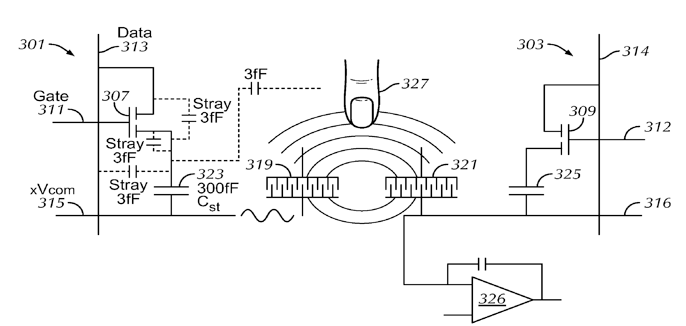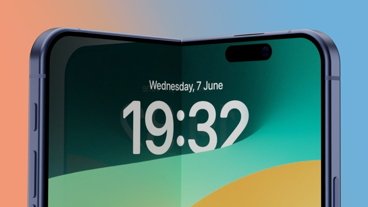The application, entitled "Display with Dual-Function Capacity Elements," describes a pair of voltage lines that run across adjacent display pixels. With the described technology, capacitors could be included in the pixels of an LCD display, and could operate individually.
This method would allow panels with integrated touch sensors to be manufactured with fewer parts and processing steps, allowing the display to be thinner, lighter, and brighter. The method would eliminate the need for a touch sensor panel overlaying a display.
"These dual-function capacitive elements form part of the display system that generates an image on the display, and also form part of a touch sensing system that senses touch events on or near the display," the application reads.
"The capacitive elements can be, for example, capacitors in pixels of an LCD display that are configured to operate individually, each as a pixel storage capacitor, or electrode, of a pixel in the display system, and are also configured to operate collectively as elements of the touch sensing system."
Such technology could be employed in a number of Apple's touchscreen devices, including the iPhone, iPod touch, or its rumored tablet device. The patent application was originally filed on Sept. 29, 2008, and the invention is credited to Steve Porter Hotelling, Shih Chang Chang, Lili Huang, and John Z. Zhong.
Another touchscreen-related patent, entitled "Ambient Light Interference Reduction for Optical Input Devices," describes how ambient light can affect an optical touchscreen sensor on an LCD screen. These photosensors are different from a capacity sensor typically used to recognize surface contact.
The problem with photosensors, the application notes, is that they rely upon shadows being cast upon them, which can be falsely triggered due to changing light conditions. Because of this, ambient light can render the technology unreliable.
"Photosensors are not able to readily distinguish between decreases in light associated with a user's specific input and decreases in light occurring from changing environmental conditions," it states.
The application describes technology that could provide an independent light source that would create electromagnetic signals that cover the glass of the display.
"When the user's finger is proximate to a certain region of the touch panel, the electromagnetic signals reflect off of the user's finger and back through the cover glass," the application reads. "One or more photosensors monitoring the presence of these reflected signals service the various regions on the touch panel where input may be detected.
"Thus, when the reflected signals are detected at a certain region, the user's finger may be assumed to be present. In this manner, input to the optical device can be properly detected despite variations in ambient lighting."
The patent application was filed on July 2, 2008. It is credited to Steve Porter Hotelling and Stephen Brian Lynch.
 Neil Hughes
Neil Hughes







-m.jpg)






 Christine McKee
Christine McKee
 Charles Martin
Charles Martin
 Mike Wuerthele
Mike Wuerthele
 Marko Zivkovic
Marko Zivkovic
 Malcolm Owen
Malcolm Owen


 William Gallagher
William Gallagher
-m.jpg)






22 Comments
That shapes to be what we at AI were repetitively (1)(2) calling fantastic!
Hopefully Apple will also address the reflective issues of these glass devices.
There is glass available that has <1% surface reflection rate.
What this does is amazing, it allows clear vision of the computer image with virtually no reflections or glare. No hazing of the image like matte screens do.
It's like glossy screens on steroids. People would love it and it would separate Apple's devices from the less quality highly shiny PC tablets and computer screens.
Very nice.
The heart of Apple forever beats with innovations and ingenuity.
(BTW, can we officially kill the word innovation. I'm completely sick of its overuse. Blech.)
Hopefully Apple will also address the reflective issues of these glass devices.
There is glass available that has <1% surface reflection rate.
What this does is amazing, it allows clear vision of the computer image with virtually no reflections or glare. No hazing of the image like matte screens do.
It's like glossy screens on steroids. People would love it and it would separate Apple's devices from the less quality highly shiny PC tablets and computer screens.
Woh hold on! Please explain the uses of this technology slowly to me and it's potential for Apple devices.
If I am understanding this correct, the possibility to simply have your hands hovering over the surface and make suggestions will possible? The "uNtouch" Tablet is here? That would be awsome!!! This might not come right away, but the road seems open...
Edit: I read a thing or two wrong i suppose and got a little bit TOO exited. Well fortunately my imagination is still impact Still a cool patent though!